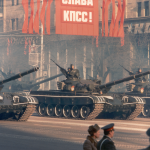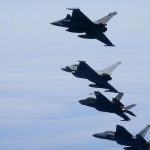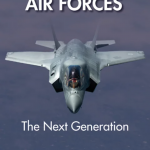On 17 January 2022, the Government of the United Kingdom announced that it would be supplying weapons to Ukraine. The first Royal Air Force (RAF) flight began delivering weapons to Ukraine on the same day. As 2022 came to a close, the RAF Air Mobility Force (AMF) had flown over 240 flights and transported thousands of tonnes of weapons, equipment, and personnel on an airbridge that stretched from the UK to Eastern Europe and beyond. This article will examine the UK’s use of air mobility in the Ukrainian conflict, an air power role that, since February 2022, has been vital in sustaining Britain’s contribution to the war.
The important but boring bit – doctrine, definitions, and scope1
UK doctrine states that Air Mobility provides the ability to deploy, sustain and recover personnel and equipment. It consists of three mission types: airlift, air-to-air refuelling, and personnel recovery. This article will focus on airlift. However, it is worth noting that RAF Voyager tankers have supported the massive intelligence surveillance and reconnaissance and defensive counter-air efforts along NATO’s eastern borders.
The international airlift effort – military and civilian
Although this article focuses on the UK airlift effort, it is interesting how other nations use the capability. Unsurprisingly, the largest air mobility contribution comes from the United States Air Force (USAF); like its military aid contribution, the scale of its airlift effort dwarfs other protagonists. The USAF’s efforts have also been supported by several commercial charter companies drawn from the Civil Air Reserve Fleet.

NATO’s fleet of 3 C17s, the heavy airlift wing (HAW), has recently been seen transporting artillery shells from Norway. The HAW operates from Hungary, which is somewhat ironic given that country’s attitude to the war. The German Air Force has also conducted a number of aeromedical flights from Poland to a range of German cities. That Canadian C17s have recently transported Leopard tanks to Europe is a powerful reminder that the speed and reach of airlift can also play an important role in the information war.
The charter market has also seen Antonov Airlines’ An124 aircraft delivering support to Ukraine. These aircraft may be operating as part of NATO’s SALIS agreement – last used by the UK during the withdrawal of combat troops from Afghanistan. The US Civil Air Reserve Fleet and SALIS provide guaranteed access to the commercial market but come at a price. The UK prefers to access the market through enabling contracts. This is a tried and tested system that eschews guaranteed access for a flexible approach using trusted brokers. Both approaches have their merits. What is clear is that the size and scale of the Ukrainian airlift is beyond that of purely military transport aircraft.

From the Russian perspective, Iran has used Boeing 747 and Ilyushin transport aircraft to supply drones to Moscow. It is difficult to imagine any significant potential contribution from China would not take place without airlift being involved. The Chinese are clearly capable of such an effort, having delivered FK-3 surface to air missile systems to Serbia using six Y-20 transport aircraft in April 2022.
The UK contribution – from surge to airbridge
The RAF began delivering NLAW anti-tank weapons to Ukraine ahead of the Russian invasion. Flight Radar 24 shows the RAF flew over a dozen sorties into Ukraine (Kyiv and Lviv) prior to the 24th of February. The RAF air transport fleet has also gone beyond the borders of Europe to help the UK secure ammunition and military equipment from third party countries.
Intense activity in March 2022 (30 C17 sorties) mirrored the Government’s increased military support to Ukraine. Since then, the effort has taken the shape and feel of an airbridge with approximately 10-12 C17 flights operating per month. That is not to say that other surges have not taken place – the figure leapt to 19 flights in September 2022, for example. Flight data for the month of January 2023 showed a total of 10 sorties were flown, with half of those taking place over a period of just 9 days between the 4 and 13 of the month. The ability to surge and flex in response to a series Government announcements on weapon supplies is something unique to air. It is interesting to see that as of February 2023, the A400M appears to have joined the airlift effort (more on this later).
The majority of the RAF’s flights have used the Polish airport of Rzezsow as an international logistics hub. The flexibility offered by air mobility allows discreet loads to be delivered in sequence, so as not to exceed airport capacity (in terms of aircraft on the ground or the quantity of explosives that can be stored or handled there). Timely and flexible delivery also helps with the equipment’s onward movement.

Each time, the RAF’s AMF responded to the need. It has done exactly what UK doctrine asks by ‘creating rapid strategic influence in support of UK national objectives, or in support of a key ally’. Events in Ukraine have reinforced how critical air mobility is to a major land war.
Demonstrating global reach – Pakistan
The ability to surge beyond the UK and to provide air transport for those nations that may lack the capability has been a standout feature of the RAF’s efforts to date. In November 2022, the Ukrainian Foreign Minister, Dmytro Kuleba, said that partner countries were working with third ‘unofficially involved countries’ to purchase additional materiel for further transfer to Ukraine. There is clearly a scramble for soviet-era weapons and munitions which the Ukrainian Army will be familiar with. It seems that the RAF has played a role in facilitating the movement of weapons and equipment belonging to these third nations.
The UK Government’s Research Paper on Military Assistance to Ukraine does not list Pakistan as a contributing nation. This is despite a Ukrainian weapons tracking site showing 122mm shells manufactured in Pakistan were being used by Ukrainian gunners. The report came shortly after it was revealed that a RAF C17 aircraft had made approximately 12 trips between Nur Khan Air Base in Rawalpindi, Pakistan to Cluj International Airport in Romania.

These flights, which took place between the 6th and 21st of August came only two weeks after the UK Government announced it was supplying Ukraine with 50,000 shells. Given that it takes several days to obtain diplomatic flight clearances across the Middle East, the RAF responded to the UK announcement as quickly as possible – a clear demonstration of speed and reach. Equally, the latest, much larger shipment weapon shipment from Pakistan also highlights the value of surface lift when it comes to bulk.
Demonstrating global reach – Jordan
We can see a similar pattern of flights being repeated from Amman in Jordan. Whereas the UK airlift of munitions from Pakistan appears to have been a one off, the flights out of Jordan have not. In May 2022, several flights emanating from Amman stopped off at Ostrava in the Czech Republic. In November, almost half of the RAF C17 flights into Poland emanated from Amman.
The only Jordanian weapon confirmed as being used in Ukraine is the RPG 32 Nashshab, a shoulder-fired anti-tank weapon. Given that this weapon weighs approximately 10kg when loaded, it is highly likely that the RAF flights carried far more substantial weapons and/or quantities of ammunition into Poland. Most equipment fielded by the Jordanian Armed Forces, including its towed and tracked artillery, is of Western origin. The exception is approximately 100 mobile SAM systems of Soviet origin supplied by Saddam Hussein in 1982 as a reward for a Jordanian volunteer unit fighting against Iran.
It may well be that the efforts out of Pakistan and Jordan may be repeated at some point. Secretary of State Ben Wallace has said the United Kingdom is looking into placing production orders for Ukraine from around the world.2
Getting to Poland without the help of an Atlas?
In August 2021 the Wavell Room published ‘We need to talk about RAF air transport’. The article was scathing about the decision published in the March 2021 Defence Command Paper to retire the C130 fleet 7 years early and spoke of a loss in overall airlift capacity. Whilst that debate is outside the scope of this article, it is interesting to note that the majority of the RAF’s Ukraine flights were conducted by C17s of 99 Squadron. The newer, more numerous, A400M has barely featured until very recently. A European route/airbridge should be meat and drink to an aircraft of its size. It is difficult to explain why an aircraft of the C17s age should be almost exclusively shouldering the burden.

A400M airframe availability is quoted as being at 70% of the fleet (13-14 aircraft) between March 2021 and September 2022. This could lead one to believe that the contractual definition of ‘available’ may not sit well with the user’s perspective. The A400 fleet has not been idle, but it has had to focus on replacing the tactical capabilities of the C130J. The decision made in 2021 to retire the C130 has meant that A400 crews and airframes have to be committed to training and obtaining the necessary tactical clearances.
Another factor that may be at play is that the A400 cannot carry a full range of warlike stores. When the C130J entered RAF service in 1999, it suffered several issues with vibration from the propellers that prevented it from carrying its full complement of passengers or from transporting certain types of explosives. It would be concerning if the A400 was still limited in this respect after such a long time in service.
Lessons so far
Air mobility has played a key role in supporting a major European land war. Both Ukraine and Russia have used air mobility to receive critical, time sensitive equipment. From a UK perspective, air mobility was involved from the outset, supplying large numbers of anti-tank weapons to the Ukrainian Armed Forces prior to the Russian invasion.

As well as demonstrating speed and reach within Europe, the AMF has also operated in support of ‘Global Britain’, transporting arms and equipment belonging to donor nations who were either unable to transport it themselves or who preferred to stay out of the headlines.
From a RAF perspective the C17 has been at the core of the UK effort. The 2021 multi million pound investment in the C17 is an excellent example of how proven, older platforms can remain in service and often outperform their newer counterparts. The newer A400’s contribution has been minimal. The reasons are unclear but after eight years, there is still work to do.
The widespread use of charter aircraft has shown that demand has outstripped supply when it comes to military airlift. We also need to bear in mind that the large-scale movement of vehicles remains the bailiwick of sea and surface movement. The Canadian Leopards were a useful reminder of the visual impact of seeing tanks being ‘flown into conflict’ – an important addition to a conflict where information operations and messaging are playing a key role. Airlift may lack the capacity of sea and surface, but its speed is vital and is uniquely suited to the rapid replenishment of ammunition.
The key message behind Andy and Sophie’s article remains extant – the UK Air Mobility Force’s role in the Ukraine conflict has seen it influence the behaviour of actors and course of events since January 2022 and long may it continue to do so.

Phil Clare
Phil Clare is a former RAF Logistics Officer. He has over 30 years experience of single and joint service environments, as well as operational experience that spans Op GRANBY to HERRICK.
Footnotes
- By examining information available from flight tracking services, it is possible to get some detail behind the RAF’s efforts over the past 12 months. Not every flight can be counted; some aircraft will operate without a transponder. For this reason, and due to its focus on tactical airlift, the work of the C130Js of 47 Squadron has been omitted from the analysis.
- House of Lords International Relations and Defence Committee 1 November 2022. (https://parliamentlive.tv/event/index/c13f3b65-b1b1-481f-911c-db5bece33b9f at 15:57hrs)





